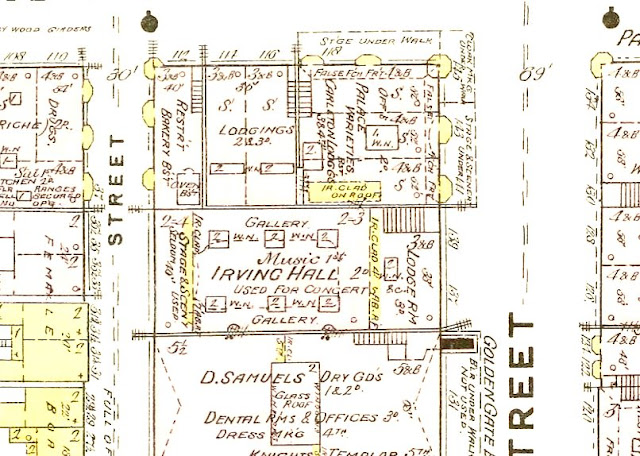SE corner of Post & Grant | map |
Opening: This saloon and variety theatre was running by 1881. It's listed in that year's city directory with an address of "SE cor Post & Dupont" and P.V.T. Mathias & Co. as proprietors. It was a venue in the basement of a four story building. The Carlton Lodgings were on the upper floors.
In the 1882 city directory T.F.A. Oberneyer was listed as proprietor. On a list of amusement venues in an 1882 Guide Book and Street Manual they mistakenly list it as being at Post and Kearny. In the 1887 directory the address is given as the SE corner
of Post and Dupont.
"Palace Varieties" is shown in this detail from image 23 of the 1887 Sanborn Real Estate Survey Map. That's Morton St. on the left, now called Maiden Lane. Grant, earlier known as Dupont, is across the top. On the right it's Post St.
On the Post side the they show "Stage and Scenery Under" - meaning under the sidewalk. Under the Grant sidewalk they have storage. Thanks to Art Siegel for locating the map in the Library of Congress collection. Irving Hall, seen just to the east of the Palace, was a new name for the building that opened in 1862 as Dashaway Hall.
Art researched the Palace and notes: "I found a number of newspaper mentions of the venue, all pretty much crime reports, and referring to it as a dive, which was coming into usage as a term for basement establishments that one could dive into. An amusing article in the April 4, 1892 San Francisco Call was written by an intrepid reporter who was 'shocked, shocked' to find these 'theaters' in our fair city, names them all, in particular:
"CRIME HATCHERIES. Life in San Francisco's Dens of Depravity. PLACES WHERE VICE RUNS RIOT. Jack Hallinan's Notorious Cremorne Theater. A PLACE THAT SHOULD BE CLOSED. Other Vile Resorts in This City Where Youth Is Corrupted and Women Slowly Slain... Life In the dives of San Francisco: What is it like? Tell us not that it is picturesque. Say not that it is permissible; that the low and vulgar will be low and vulgar, no matter what is said or done. Say that it is vile, and you have spoken of it in fit terms— sharp, short and to the point. Vile is the word.
"There are different kinds of dives. There is the underground hall, where the fetid air reeks with a stench that never leaves the place night or day; where young maidenhood is debauched; where innocent youth becomes laden with foulness; where robberies are concocted; where men are slain; where licentiousness rules supreme. There is the hall just off the street, perhaps a step or two up from the sidewalk, which is just so many steps downward into Hades for those who go in as participants. Here, possibly, it is a little cleaner in a physical sense, though morally it is just as foul and loathsome as the dive-cellar. Then there are a few places where one goes upstairs in order to gain entrance. So far as good air and decency are concerned nothing is gained by the ascent. The upstairs places are just as vile as those in the cellars. Often they are worse.
"But they are all dives, whether above or below ground. The 'Century Dictionary' gives the definition if a dive as that of 'a disreputable place of resort, where drinking and other forms of vice are indulged in, and commonly vulgar entertainments are given.' So it may be in a cellar or in an attic. If it conforms to the foregoing definition putting it upstairs does not let it escape from the appellation of 'dive.' But there is a bitter name for them — crime hatcheries. That is what they are. The police records will prove it. Now, there are a great many dives in San Francisco. If there were only one, that would be one too many. Some of them are hidden away out of sight. Others flaunt themselves brazenly on our leading streets, their blatant bands of harsh music sending forth their discordant notes nightly.
"THERE ARE MANY SUCH. Dives That are Moral Stenches to the Community... There are many dives in San Francisco— many more than in any other city of its size. We may be lacking in many things, but not in dives. Our gilded youth are well provided for in this respect, and the pitfalls for our own sons and daughters are numerous and varied. No; we are not backward in iniquity... The Palace Varieties, in the cellar at Grant avenue and Post street, deserves especial mention for its especial indecencies, but do not expect to see the unusual there. Only the most vulgar and commonplace performances are in vogue at this— and all— the dives... The main feature of all the dives are the female waiters. They are mostly aged, all are brazen and but few even passingly good looking. Yet they serve their purpose. They make the dive-keeper rich."
Thanks to Art Siegel for all his research on this building.
Status: Dior is now the tenant on the ground floor of the building currently on the site.
More information: Well, there isn't any yet.
| back to top | San Francisco Theatres: by address and neighborhood | alphabetical list | list by architect | pre-1906 theatre list | home |





No comments:
Post a Comment